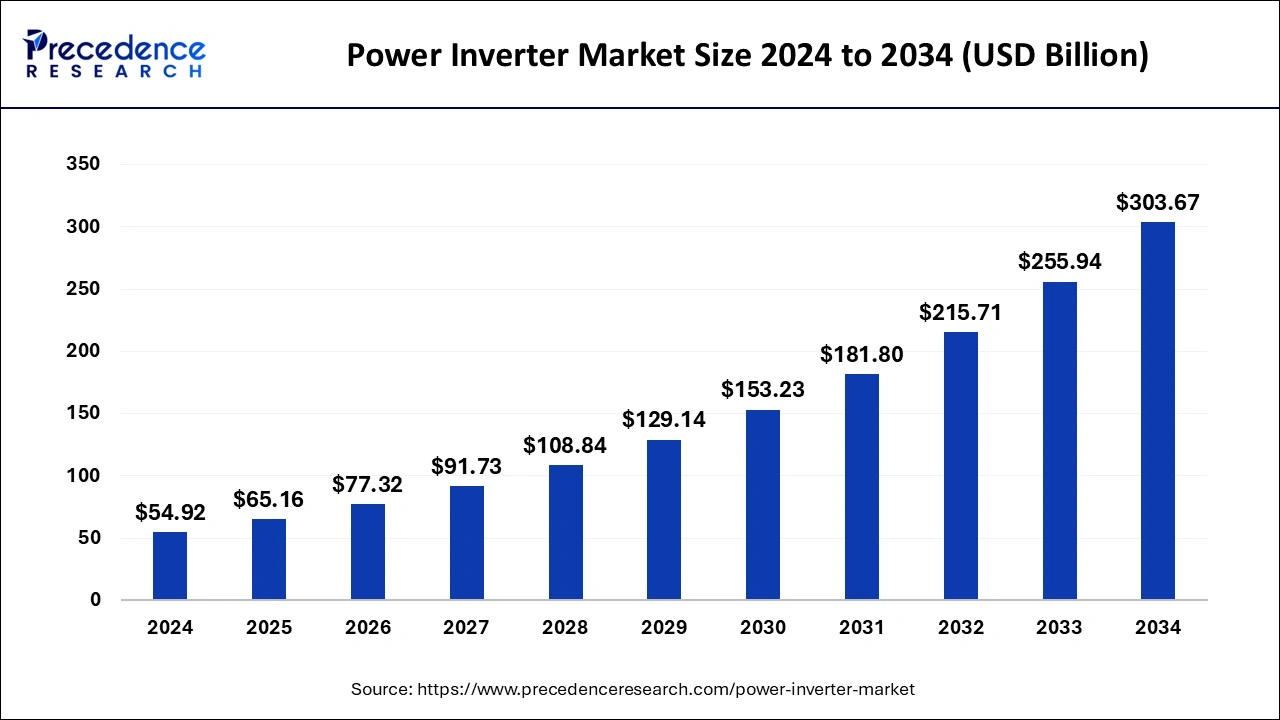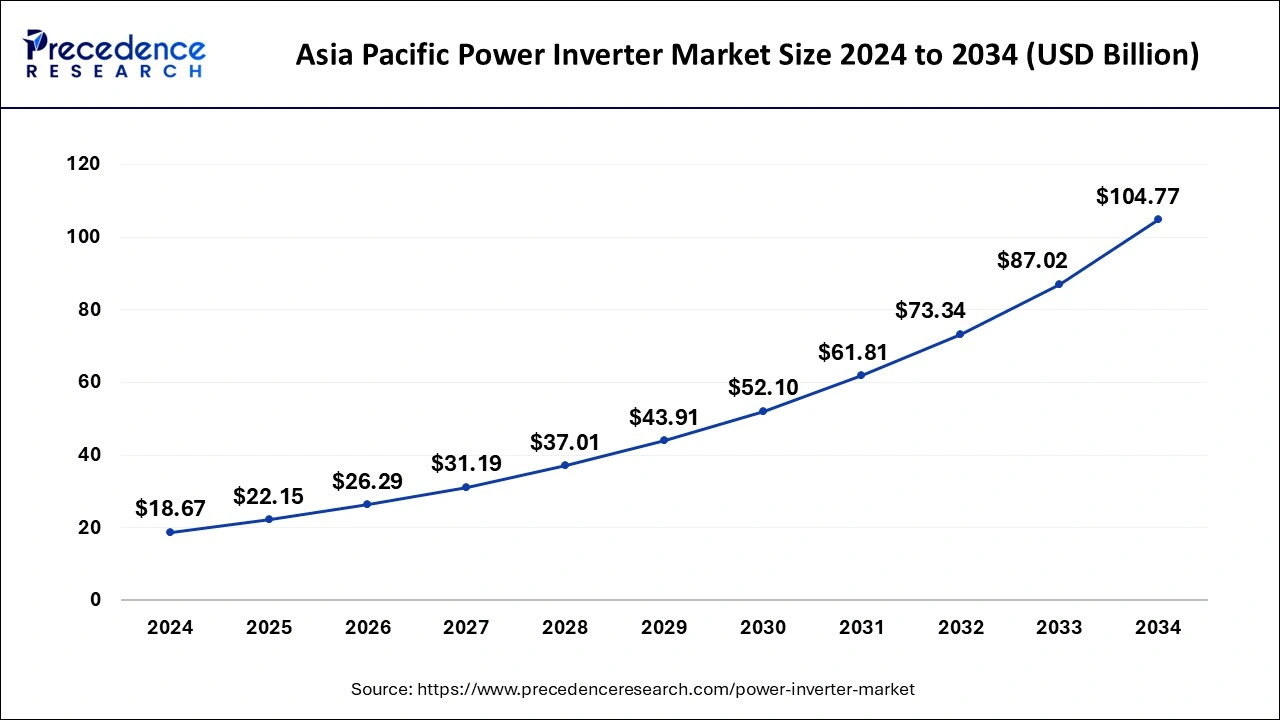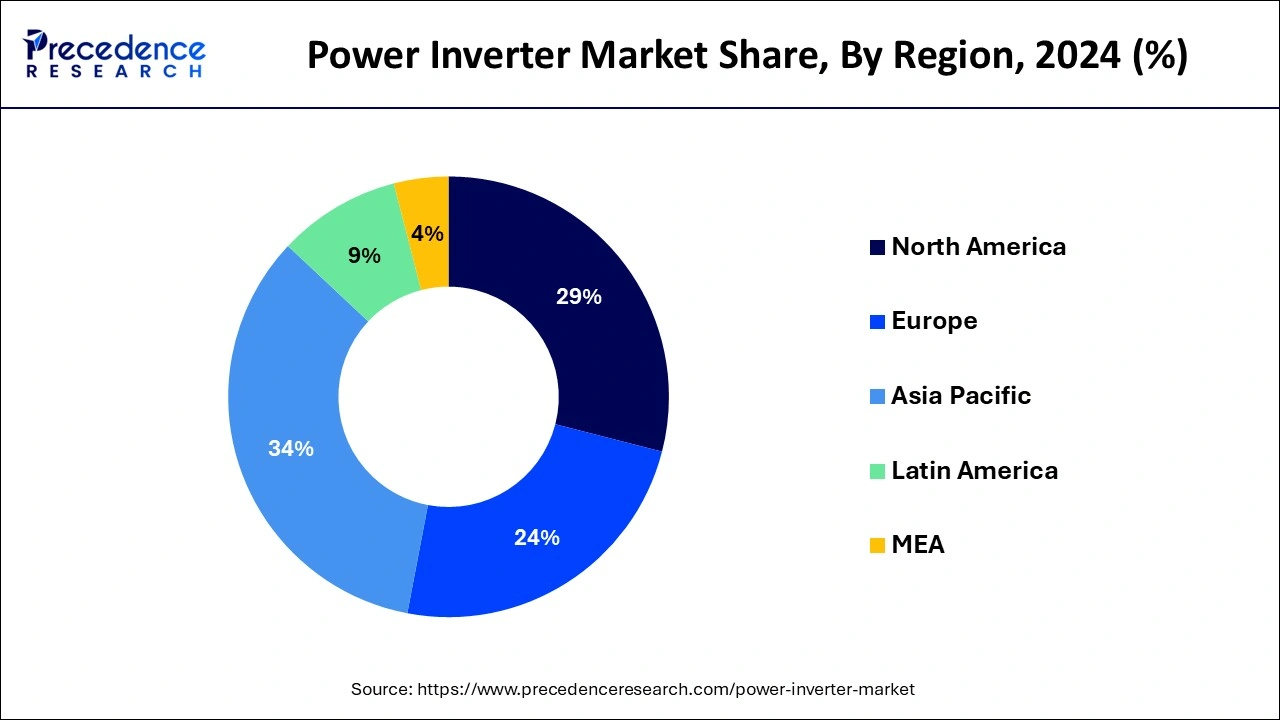September 2024
The global power inverter market size is calculated at USD 65.16 billion in 2025 and is forecasted to reach around USD 303.67 billion by 2034, accelerating at a CAGR of 18.65% from 2025 to 2034. The Asia Pacific power inverter market size surpassed USD 22.15 billion in 2025 and is expanding at a CAGR of 18.82% during the forecast period. The market sizing and forecasts are revenue-based (USD Million/Billion), with 2024 as the base year.
The global power inverter market size was estimated at USD 54.92 billion in 2024 and is anticipated to reach around USD 303.67 billion by 2034, expanding at a CAGR of 18.65% from 2025 to 2034. from 2025 to 2034. The integration of renewable energy, portability, energy efficiency, and continuous power supply are the major rationales behind the success of the power inverter market.

Artificial intelligence is transforming power systems with technological changes. AI helps to reduce computational time, decrease utility and consumer costs, and ensure the reliable operation of an electrical power system. AI techniques can automate and improve the performance of power systems. AI techniques are integrated into power system operations, control and planning, and various applications.
AI can resolve system frequency changes and maintain the voltage profile that minimizes transmission losses and reactive current in distributed systems and reduces the fault rate. AI helps to increase the power factor and improve the voltage profile. AI can improve the efficiency of electrical automation management, address the risk of accidents, and ensure the smooth operation of the power system for a long period.
The Asia Pacific power inverter market size was evaluated at USD 18.67 billion in 2024 and is predicted to be worth around USD 104.77 billion by 2034, rising at a CAGR of 18.82% from 2025 to 2034.

Asia Pacific led the global power inverter market with the largest market share of 34% in 2024 and is estimated to be the most opportunistic market during the forecast period. The rapid industrialization, rapid urbanization, rising disposable income, improving lifestyle, and rising standards of living in the region are some of the major factors that drives the growth of the Asia Pacific power inverter market. The rising government initiatives and investments in the development of the rural regions and electrification is positively impacting the market.
The growing number of real estate projects in the rural areas is expected to boost the demand for the power inverters owing to the fluctuating power supply in the rural areas. Moreover, the rising awareness regarding the power inverters along with the easy availability of the power inverters in the sub-urban and rural areas of the Asia Pacific is expected to contribute significantly towards the market growth. Hence, the Asia Pacific power inverter market is expected to witness a considerable growth rate during the forecast period.

North America is anticipated to be the fastest-growing region in the power inverter market during the forecast period with the U.S. as the major contributing country to the regional market’s growth. The U.S. leads as the prominent market due to the presence of several power inverters. The dominance of 60 KW plus capacity-three phase string inverters and 1.5 MW plus capacity central inverters is contributing to the success of the U.S. country. The Solar Energy Industries Association states that the U.S. showcases a cumulative installation of 153 GWdc solar capacity during the first quarter of the year 2023 and is expected to reach around 375 GWdc by 2028. The photovoltaic solar installations with new electricity generating capacity additions were remarkably grown in the first quarter of the year 2023. The rising adoption of solar power inverters is expected to be the prominent growth factor for the regional market’s growth in the coming years.
A power inverter refers to an electronic device upon which several factors depend which includes input voltage, output voltage, frequency, and overall power handling. It can be a combination of mechanical effects and electronic circuitry. Moreover, solar power inverters are an integral part of large solar systems. They have the potential to convert direct current electricity into alternate current and can determine the efficiency of the whole solar system. The focus on minimizing the power generation costs propels the market’s expansion. According to the International Renewable Energy Agency (IRENA), power inverters will expand significantly over the next 30 years. Several government policies supported the adoption of clean energy and helped to decline renewable energy prices. The reduced installation costs of inverters, cells, solar modules, and related equipment boost the demand and need for the power inverter market.
| Report Coverage | Details |
| Market Size in 2025 | USD 65.16 Billion |
| Market Size by 2034 | USD 303.67 Billion |
| Growth Rate from 2025 to 2034 | 18.65% |
| Largest Market | Asia Pacific |
| Base Year | 2024 |
| Forecast Period | 2025 to 2034 |
| Segments Covered |
Type, Application, End User |
| Regions Covered |
North America, Europe, Asia-Pacific, Latin America, and Middle East & Africa |
The rising awareness of people regarding environmental issues and efforts to reduce carbon emissions are driving the demand for clean energy solutions in the form of power inverters. Countries like the U.S. and China are leading in constant economic growth and development in the supply chain. The favorable government policies support the production of power inverters in the U.S. and China which drives their adoption and solar power inverters as well.
There can arise issues regarding elevated DC voltages and high voltages can present risks to installers, firefighters, and maintenance personnel. The costs of installation, maintenance, and
marketing can be financially tough for some people dealing with this. The short-circuit situations can be problematic presenting health risks to the workforce.
The power inverters have wide applications in the automotive field. They are in high demand for electric vehicle powertrains. Vehicle inverters have the potential to power the onboard electric systems and motors of vehicles. There are leading and noticeable manufacturers and providers of vehicle inverters including Toyota Industries (Japan), Sensata Technologies (U.S.), Delphi Technologies (UK), etc. which contribute to the expansion of the power inverter market.
The 5-95 KW segment dominated the power inverter market in 2024 due to its great utilization in rail traction and electric vehicles. An electric car has the potential to go around 100 miles on 30 KW of energy and hence electric vehicles launched in 2022 can travel about 400 miles on 100 KW of power. With the increased use of 100 KW of power by electric vehicles, demand for power inverters will also increase.
The 100-495 KW segment is expected to grow at the fastest rate in the power inverter market over the forecast period. This segmental growth will be due to the huge adoption of electric vehicles capable of traveling on 100-495 KW of energy in the coming years. This power energy serves as a traction inverter in rail traction that can convert AC power into DC power for the DC motors used in locomotives. The increased awareness of consumers regarding the benefits of using electric vehicles for environmental sustainability will accelerate the growth of this segment. The rise in petroleum fuel prices and government initiatives and policies encourage the purchase of electric vehicles driving the demand and need for this power energy segment.
The residential segment dominated the market in 2024. The rising government expenditure on the development of infrastructure and electrification has fueled the adoption of the power inverters among the residential users. The rising number of residential structures and rising urbanization is a major factor that fuels the deployment of the power inverters in the residential units across the globe. Moreover, the increasing demand for the various consumer electronics among the household consumers will foster the demand for the power inverters in the residential segment.
The commercial segment is expanding at a notable CAGR during the forecast period. This can be attributed to the increased demand for the uninterrupted power supply in the commercial units like malls, gyms, and other commercial spaces. The regular power supply is essential for the smooth operation of the commercial activities and any interruption in the power supply may result in huge financial loses to the commercial units. Hence, the adoption of power inverters in the commercial units is expected to grow rapidly during the forecast period.
The motor drive segment contributed the highest market share in 2024. This is attributed to the increased popularity and increased adoption of the motor drives across the globe. The motor drives accounts for around 45% of the electric energy consumption across all the electric appliances. The increased efficiency of the motor drives has boosted the growth of this segment in the global power inverters market.
The EVs/HEVs segment is growing at a solid CAGR during the forecast period. This is simply attributed to the increased adoption of the electric vehicles across the globe. The rising concerns regarding the vehicle emissions has forced the government to develop policies that encourages the adoption of the EVs and HEVs. The rising government initiatives to restrict the carbon emission from vehicles is significantly boosting the growth of this segment. Moreover, the surging popularity of the autonomous vehicles among the consumers is further expected to fuel the growth of this segment in the forthcoming years.
By Type
By End Use
By Application
By Geography
For inquiries regarding discounts, bulk purchases, or customization requests, please contact us at sales@precedenceresearch.com
No cookie-cutter, only authentic analysis – take the 1st step to become a Precedence Research client
September 2024
September 2024
August 2024
January 2025